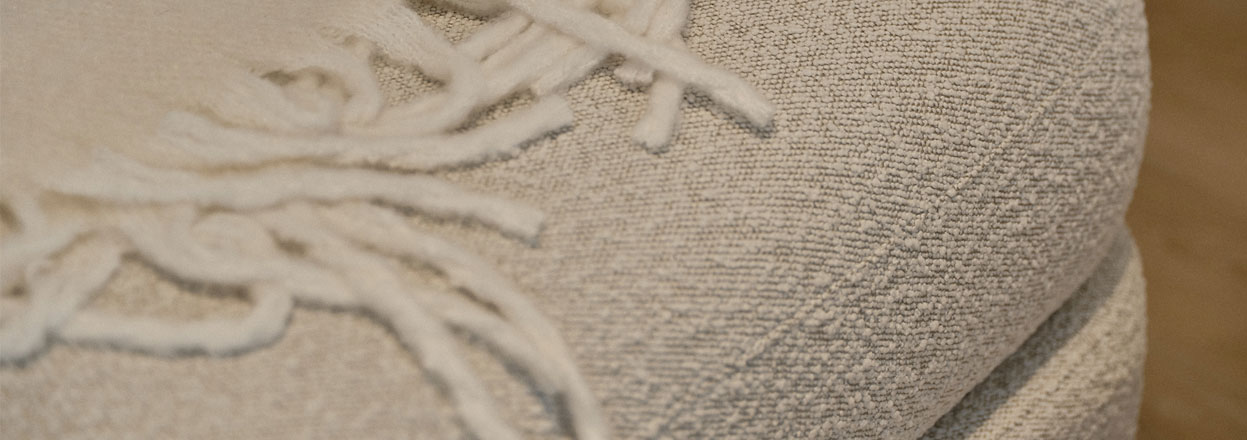
Have you ever wondered what the items noted on an upholstery fabric label mean? They may seem confusing but they are actually there to help you out. When shopping for upholstered furniture, the fabric's characteristics can mean the difference in enjoying your sofa for 10 months or 10 years.
Below you'll find a list of items that can help you make the best choice to suit your situations and requirements. While each fabric swatch label may have all or just some of these, reach out to the furniture retailer, furniture manufacturer, or the fabric maker for more information.
Fiber Content
These are the materials used to make a fabric. These include both natural and synthetic (manmade) materials.
For instance:
Synthetic materials include but aren't limited to polyester, rayon, nylon, acrylic, and microfiber.
Natural materials include but aren't limited to plant derived fibers of cotton, flax, bamboo and animal sourced fibers of wool and silk.
It is important to know the fiber content of a fabric to better understand which one is best for your situation.
Abrasion Rating/Rub Count
The abrasion rating or rub count of an upholstery fabric is one of the most important specifications you can look to when you're in the market for upholstered furniture.
Since the wearability of a fabric is measured during a rub test in rub counts, you'll want to understand each potential fabric's ability to withstand repeated rubbings and how long it takes for the material to become worn through.
The ratings or counts you'll find on the label include Heavy Duty (above 20,000 rubs), Medium Duty (12,000 to 20,000 rubs), and Light Duty (9000 to 12,000).
To understand more in depth about how to choose the best fabric rating or rub count, check out our guide "How to Read Upholstery Fabric Rub Test & Counts."
Pattern Direction
The pattern of the majority of upholstery fabric is "railroaded" or the fabric or "up the roll". These terms are interchangeable in meaning the fabric's design (pattern) is meant to run vertically north to south when placed on a piece of furniture such as sofa, chair or bench.
The U.S. standard width for upholstery fabric is 54-inches. There are some exceptions to some fabrics widths like 60-inch or 72-inch, but 54-inch allows for the least cutting-waste.
Cleaning Codes
Please note, cleaning of upholstery fabric requires a deeper understanding prior to purchase so you choose the upholstery fabric best suited to your household. For more information, look to our in-depth guide "Explaining Fabric Cleaning Codes."
Here is a brief overview of the cleaning codes you will see on fabric upholstery fabric swatches and labels. However, it is very important you refer to the fabric manufacturer cleaning instructions before attempting to clean your upholstered furniture.
“W”—Code W stands for ‘Water based cleaner’'. This means they are the easiest to spot clean (this does not mean you can wash the cushion covers in the washing machine.) You may clean these types of fabrics with a water-based foam or shampoo form of upholstery cleaner.
“S”—Code S stands for solvents (dry clean only). You can spot treat stains lightly with a water-free solvent or dry-cleaning solvent. Always use solvents away from fire or flame in well-ventilated spaces.
“W/S”—Code W/S code means you may use a combination of dry cleaning solvents and water-based cleaners. The fabrics may be spot cleaned with a water-based foam or shampoo form of upholstery cleaner, or a mild dry cleaning solvent. This is for spot cleaning only, not all-over cleaning.
“X”— Code X fabrics should be cleaned by vacuuming or light brushing only. This code means the upholstery fabric is not to be cleaned with water-based or solvent cleaners.
Fire Rating Codes
Please note, the following information is for residential upholstery fabrics only. (Commercial fabrics are rated according to different fire tests.)
UFAC Class I: The fabric is exposed to a burning cigarette covered in sheeting material. The cigarette has to burn its entire length. Class I means the fabric passed for residential applications.
Cal. 117 Sec E: The fabric is touched by a 5/8” long pencil-thin flame for 1 second. The code means it did not ignite.

